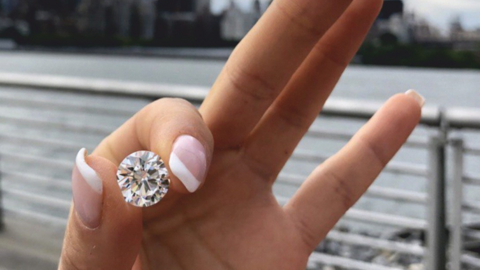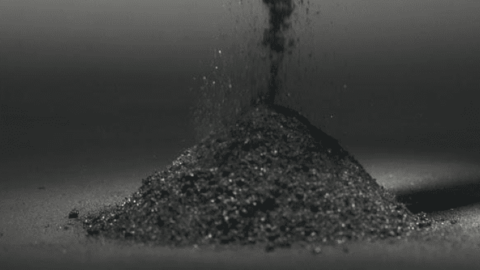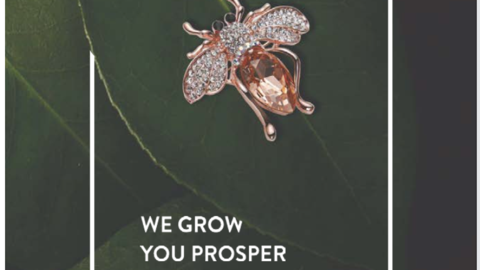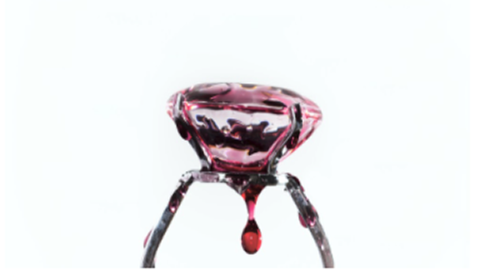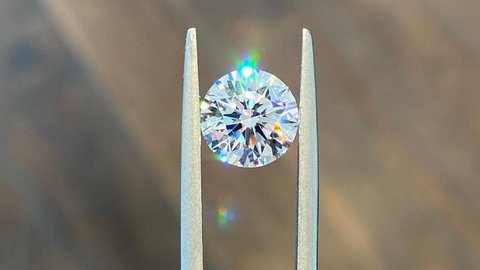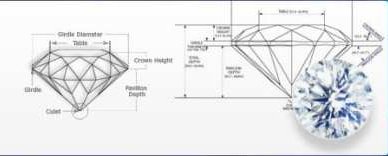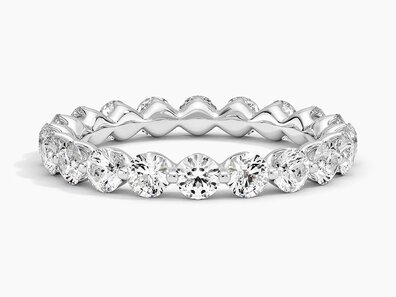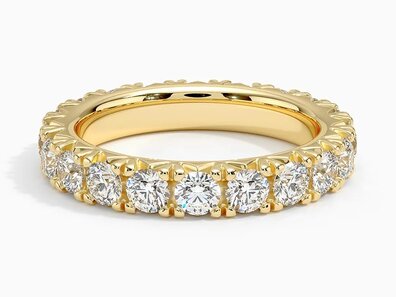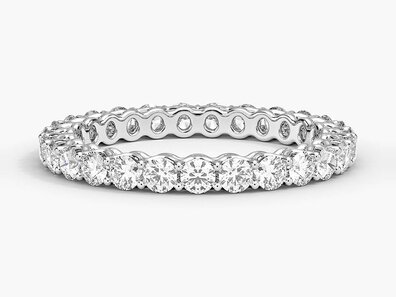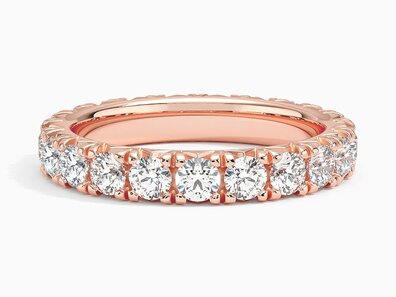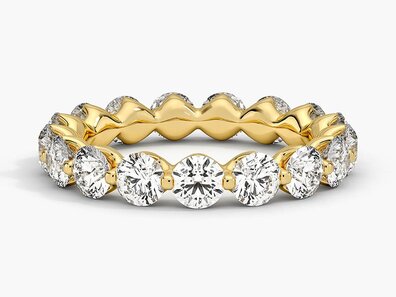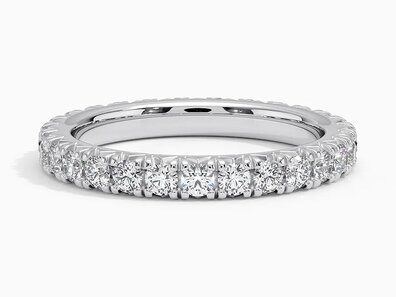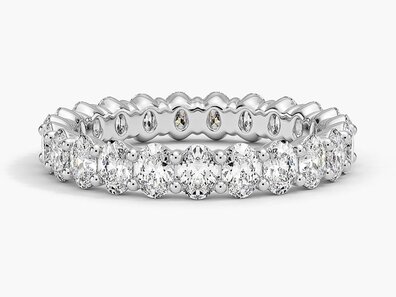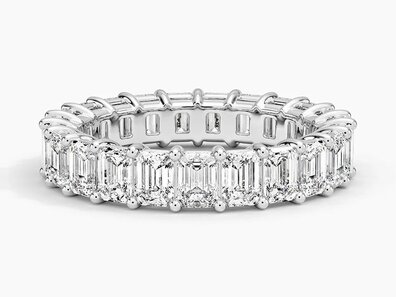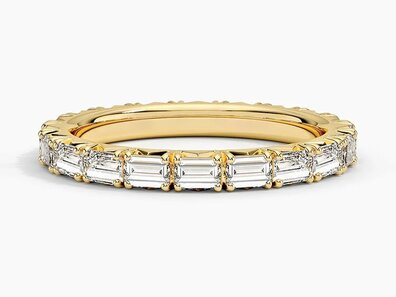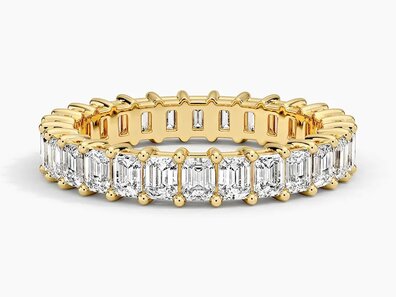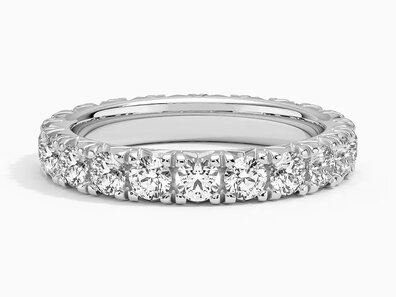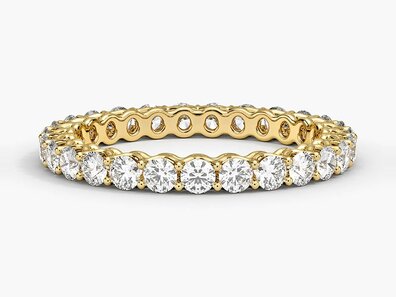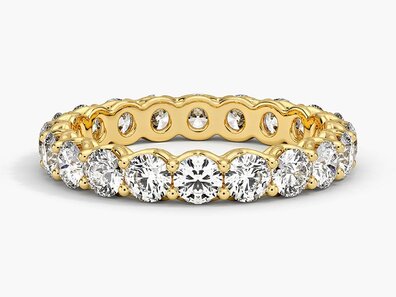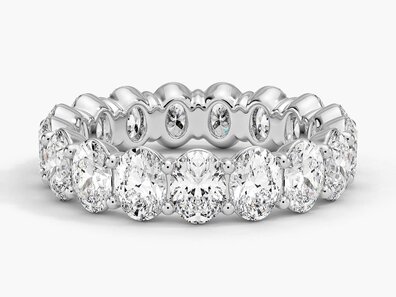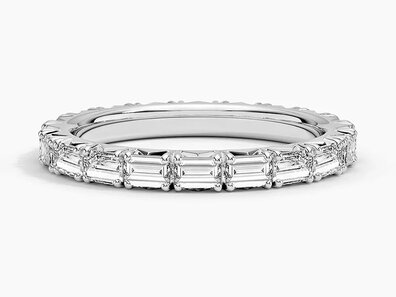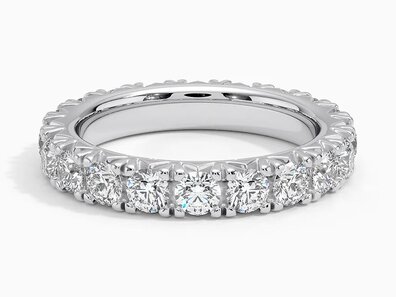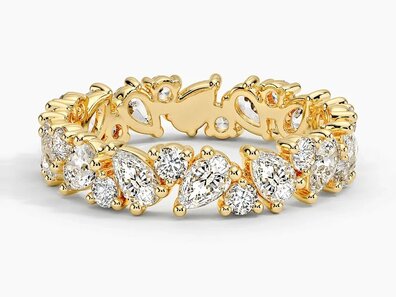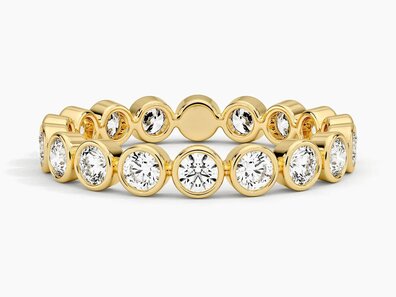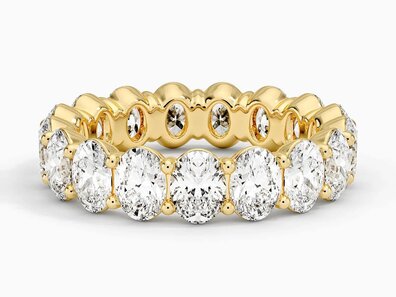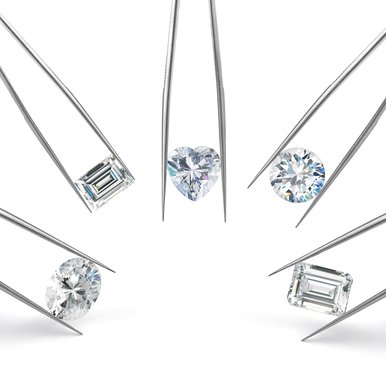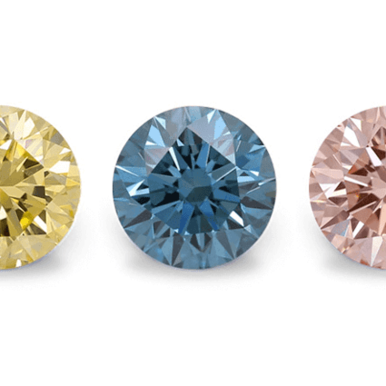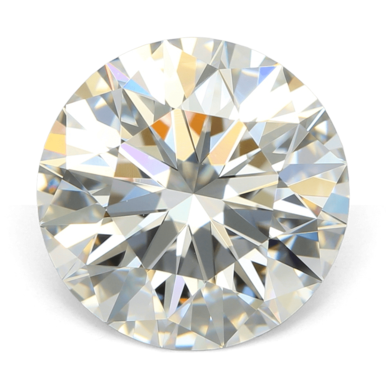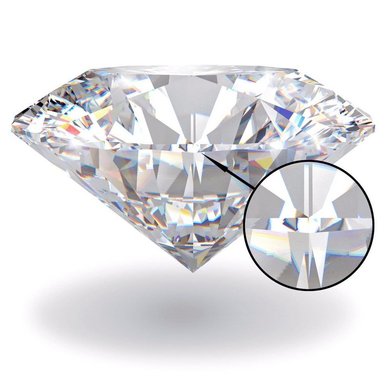Anniversary Wedding Lab-Grown Diamond Rings: Celebrate Love
Author: Alex K., CMO at Labrilliante Updated: 2025-11-25 Reading Time: 18 minutes
Quick Take: Anniversary rings transform relationship milestones into wearable timelines—each band marking commitment chapters through stackable designs or symbolic eternity circles. Lab-grown manufacturer-direct channels deliver 2-4 carat VS1 clarity platinum bands at $2,000-$4,000, prices that bought 1-carat SI1 gold rings in mined-diamond retail. IGI certification, lifetime warranties, and metal specification archives enable decade-spanning jewelry collections where each addition perfectly matches originals—building love stories generic catalogs can't replicate.
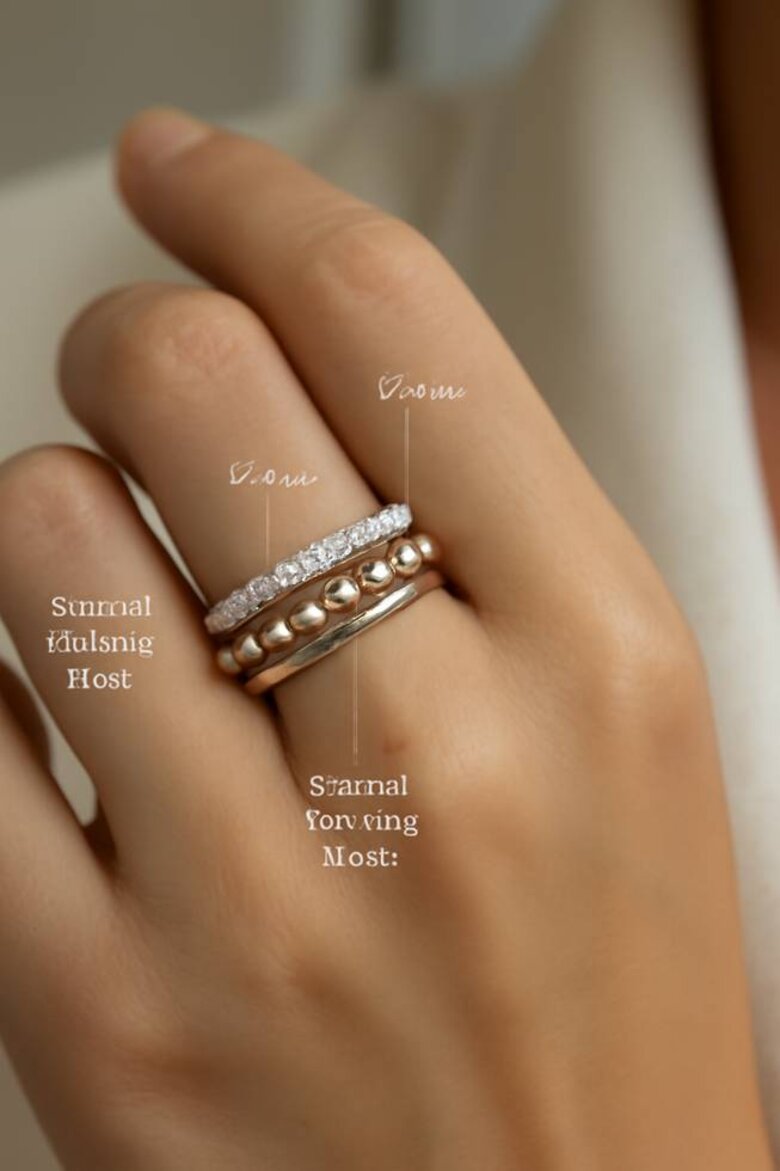
Marriage milestones deserve symbols as enduring as the commitment they represent—yet traditional jewelry economics forced couples to choose between meaningful purchases and financial responsibility. Anniversary wedding lab-grown diamond rings eliminate that compromise entirely. This guide reveals how manufacturing innovation and direct-to-consumer channels democratized luxury once reserved for affluent buyers: the engineering behind eternity symbolism, metal choices affecting decades of wear, certification protecting investment quality, and why manufacturer relationships compound value across multiple milestones. You'll understand which designs translate abstract forever-commitment into tangible beauty, and how strategic sourcing multiplies carat weight without multiplying cost.
When Natural Diamonds Still Make Sense: The Resale and Heirloom Argument
Critics of lab-grown anniversary bands raise legitimate concerns about long-term value retention and multi-generational heirloom potential. Natural diamond jewelry maintains secondary market liquidity—a 2-carat DEF/VS1 mined eternity band resells at 40-60% of original retail value through established auction houses and estate buyers. Lab-grown equivalents currently face minimal resale infrastructure with values plummeting to 10-20% of purchase price due to continuing production cost declines. For families viewing jewelry as portable wealth or planning estate transfers where monetary value matters, natural diamonds function as both symbol and asset.
Additionally, sentimental heirloom value carries psychological weight beyond economics. Some couples prize the romantic notion of wearing stones formed over billions of years—geological rarity as metaphor for relationship uniqueness. When grandchildren inherit natural diamond anniversary bands decades hence, the mined origin story might resonate more powerfully than laboratory growth narratives. These aren't irrational preferences. They reflect values where symbolism intertwines with provenance.
However, this argument applies primarily to couples prioritizing future liquidity over present experience, or valuing origin mystique above identical physical beauty. For the 80%+ of anniversary jewelry buyers who never resell pieces and whose children inherit based on sentimental rather than monetary value, lab-grown delivers superior immediate satisfaction through larger stones, better clarity, and premium metals at equivalent budgets. The resale disadvantage becomes irrelevant when selling was never intended. Meanwhile, heirloom emotional value derives from the relationship story the ring represents—not whether carbon crystallized underground or in a reactor. Most couples building anniversary collections across decades benefit more from manufacturer-direct lab-grown economics enabling multiple milestone pieces rather than single mined purchase constrained by traditional pricing. Strategic choice depends on whether you're building wearable relationship timeline or portable investment portfolio.
Meaningful Anniversary Ring Designs That Symbolize Forever Commitment
Anniversary rings feature continuous diamond bands representing unbroken commitment—each stone marking years together or shared memories. This transforms eternity bands from jewelry into tangible love stories.
The enduring appeal balances technical excellence with emotion. Round brilliant diamonds dominate because 58 facets maximize light return—your relationship shining brighter with time. Comfort fit bands feature rounded interior edges that reduce skin irritation during daily wear. Multi-stone settings require precision matching across 15-40 diamonds. Color and clarity consistency separates investment pieces from assembled inventory.
Labrilliante's design team maps milestone years onto custom stone placements within eternity bands. Manufacturing transparency enables storytelling generic catalogs cannot deliver—B2B clients report consumers increasingly request these narrative-driven designs.
[Placeholder Table: Anniversary Ring Styles Complete Comparison - Quick-reference guide comparing all major anniversary ring styles across symbolism, cost, resizing flexibility, ideal occasions, and typical carat weights to help couples select the perfect design for their milestone]
Eternity Band Symbolism for Wedding Milestones
Eternity bands traditionally mark 10th, 25th, or 50th anniversaries because continuous circles represent completeness through decades of partnership. No endpoints. No directional focus like engagement solitaires. Just geometric perfection.
Medieval European practices started gemstone gifts for specific marriage years. Modern couples reject rigid timelines. First child's birth, retirement, shared hardship recovery—these trigger purchases as often as calendar dates. Forever commitment gets celebrated on your terms.
[Placeholder Image: Traditional Anniversary Milestones Timeline with Modern Alternatives - Visual timeline showing traditional anniversary years (10th, 25th, 50th) alongside contemporary milestone triggers (first child, career achievements, overcoming challenges) with corresponding ring style suggestions for each occasion]
Stackable anniversary rings allow incremental storytelling. Each band represents renewed commitment while nesting against existing jewelry. The mechanical interlocking mirrors emotional interdependence. But this requires metal and setting consistency across years—dependencies on manufacturers maintaining specification records, not retailers with inventory turnover.
Our factory maintains client profile archives indefinitely. Exact metal alloys, stone parameters, band widths from original sets. When couples return years later requesting matching bands, we recreate from production records—not visual approximation. Direct-to-consumer retail models cannot replicate this due to supplier fragmentation.
Anniversary Ring Styles That Celebrate Your Love Story
Contemporary designs diverge into three philosophies: uniform stone sizing for classical elegance, graduated arrangements for architectural interest, or mixed-cut combinations balancing brilliance with contrast. Pavé setting dominates modern preferences—closely-set stones create 80% diamond coverage, maximizing visual impact per carat. Critical consideration? Total carat weight drives both cost and perceived luxury.
Channel settings appeal to professionals requiring snag-free profiles. Diamonds suspend between continuous metal walls rather than individual prongs. This sacrifices light entry—15-20% less brilliance than prong settings—but delivers superior durability. The trade-off? Reduced sparkle for mechanical robustness extending wearable lifespan by decades.
[Placeholder Image: Stone Arrangement Patterns Close-Up Comparison - Detailed macro photography showing three side-by-side comparisons of uniform sizing, graduated arrangements, and mixed-cut combinations with light performance demonstrations under different angles to visualize how each pattern affects brilliance and visual impact]
Romantic aesthetics increasingly incorporate 18k rose gold. Warm undertones complement diverse skin tones while evoking vintage sensibilities. Rose gold's copper content creates corrosion resistance superior to yellow variants while maintaining malleability for intricate settings. However, natural patina develops over years. Some embrace this as relationship documentation. Others see maintenance needs.
Wedding ring enhancers address couples augmenting existing bands without replacement. Contoured designs nest against engagement profiles or wrap original bands in additional diamond rows. This preserves sentimental value while adding visual presence—though it demands precise measurement and custom fabrication, not off-the-shelf purchasing.
Direct manufacturer access eliminates specification communication breaks. Clients send existing rings for digital scanning, receive wax models for physical fit testing before final casting. This prevents costly remakes common when retailers guess dimensions from photographs.
Romantic Unbroken Circle Designs for Milestone Years
Full eternity bands feature diamonds circumnavigating the entire band including palm-side surface. Uninterrupted sparkle regardless of rotation. Maximum romantic symbolism through completeness. But here's the constraint: future resizing becomes impossible without destroying the entire structure. Cutting metal disrupts stone continuity. Couples choosing full eternity essentially commit to permanent sizing.
Half-eternity bands concentrate diamonds across visible top surfaces while leaving palm-sides plain metal. This preserves resizing flexibility and reduces cost 30-40% compared to full-circle equivalents. The pragmatic compromise maintains symbolism through visible arcs while acknowledging palm-side diamonds contribute negligibly during normal positioning. The trade-off? Philosophical rather than functional loss—circles technically break even if visually undetectable.
[Placeholder Image: Full Eternity vs Half-Eternity Band 360-Degree View - Interactive-style visualization showing both ring types from top view, side profile, and palm-side perspective with annotations highlighting diamond coverage areas, metal exposure zones, and visual appearance during natural hand positioning to demonstrate practical differences]
Three-stone designs reinterpret eternity symbolism through minimalism. Each diamond represents past, present, future relationship phases. This dramatically reduces carat requirements while maintaining narrative—a 2-carat three-stone delivers equivalent presence to 4-carat pavé eternity through larger individual stones commanding attention through size rather than multitude. The style suits couples prioritizing quality over quantity, enabling VS1-VS2 clarity and DEF color at accessible prices.
Stackable strategies mark each milestone with additional bands accumulating into substantial statements over decades. A wedding band gains first-anniversary stack, 10-year eternity addition, 25-year bold piece—creating visible relationship timeline through jewelry archaeology. This distributes cost across years while building sentimental value single purchases cannot replicate.
Our manufacturing model enables multi-decade client relationships where original artisans often work on successive commissions for the same couple. This continuity ensures aesthetic coherence across decades—a benefit only accessible through direct partnerships, not retail transactions where staff turnover fragments style memory.
Lab-Grown Diamond Eternity Band Settings and Metal Options Explained
Setting selection determines visual character and functional longevity—each technique presenting engineering trade-offs between light performance, durability, and maintenance. Metal choices compound these factors through hardness variations, color stability, and hypoallergenic properties interacting with daily wear across decades.
[Placeholder Table: Diamond Setting Types Engineering Comparison - Comprehensive comparison of pavé, channel, prong, and bezel settings showing brilliance performance percentage, durability rating, maintenance frequency, snag-risk level, stone replacement difficulty, and ideal lifestyle matches]
Pavé vs Channel vs Prong Setting Durability
Pavé settings achieve maximum diamond coverage by positioning stones so closely that minimal metal appears between them. Tiny beads or prongs secure each diamond individually. This creates seamless sparkle approaching paved aesthetics—hence the French term. But vulnerability? A typical pavé band contains 40-80 individual metal attachments, each representing potential failure over decades. However, pavé delivers unmatched brilliance because stones sit high with maximum light entry from all angles.
Channel settings suspend diamonds between continuous metal walls. The diamonds nest within literal channel grooves, with metal edges burnished over stone girdles—locking through mechanical compression rather than discrete attachments. This creates snag-free profiles ideal for active lifestyles. Durability approaching solid metal bands. The trade-off involves restricted light entry—channel walls block illumination from sides, reducing brilliance 15-20% versus pavé. Additionally, replacing individual damaged stones becomes nearly impossible because removing one typically disrupts adjacent diamonds.
[Placeholder Image: Setting Construction Cross-Section Technical Diagram - Detailed cutaway illustrations showing internal structure of pavé, channel, prong, and bezel settings with labeled components (metal beads, channel walls, prong claws, bezel rims), light path arrows demonstrating how illumination enters each setting type, and stress point indicators showing where wear occurs over time]
Prong settings position each diamond on raised metal claws, maximizing light entry from all directions for optimal brilliance and fire. Four-prong configurations balance security with minimal metal visibility. Six-prong alternatives increase security at the cost of additional shadowing. Prong-set bands excel in sparkle performance but require periodic maintenance as prongs wear thin—typically needing retipping every 15-20 years depending on patterns. Elevated positioning also increases snag risk and accelerates wear through contact with hard surfaces.
Bezel settings fully surround each diamond with continuous metal rim. Maximum security. Smooth profiles preventing snagging. This proves popular for milestone rings intended for continuous daily wear in demanding environments. Though metal rim blocks light entry around stone perimeter, reducing brilliance similarly to channel settings. Bezel-set bands essentially prioritize longevity over light performance—reasonable trade-off for jewelry celebrating enduring commitment through decades.
Our setting workshops specialize in hybrid techniques optimizing across competing factors—micro-pavé with reinforced placements, channel settings with side cutouts for enhanced light, low-profile prongs minimizing snag risk while preserving brilliance. These custom solutions emerge from direct consultation with production artisans, not fixed retail catalogs.
Platinum, 18k Rose Gold, and White Gold Comparisons
Platinum delivers superior durability through exceptional density and natural white color never requiring plating maintenance. Hardness around 4.0 Mohs resists scratching better than gold while developing distinctive patina some couples prize as visual documentation of years together. Platinum's density means bands feel noticeably heavier than gold equivalents in identical sizes. Perceived luxury through tactile presence. However, platinum costs 40-60% more than 14k white gold for identical designs. Work-hardening properties mean resizing requires specialized expertise as metal becomes progressively harder with each manipulation.
[Placeholder Table: Precious Metal Properties Complete Analysis - Side-by-side comparison of platinum, 18k rose gold, 14k white gold, and 18k yellow gold showing Mohs hardness rating, density/weight feel, color stability over time, plating requirements, allergy risk percentage, cost relative to baseline, resizing difficulty, and patina development characteristics]
18k rose gold has surged in popularity through warm champagne hues complementing diverse skin tones while evoking vintage aesthetics. The alloy contains 75% pure gold mixed with copper and silver—creating exceptional corrosion resistance superior to both yellow and white variants. Copper content generates distinctive color while increasing hardness slightly over pure gold, though softer than platinum. Rose gold develops richer patina as copper oxidizes, creating warmth intensifying with wear. Some embrace this as relationship documentation. Others view it requiring periodic polishing.
14k white gold offers cost accessibility approximately 50% below platinum pricing while delivering adequate hardness for daily wear through nickel or palladium alloying. The metal requires rhodium plating to achieve bright white appearance because underlying alloy appears slightly yellow—this plating wears gradually over 18-36 months depending on patterns, necessitating periodic replating for color consistency. White gold bands essentially trade lower initial cost for ongoing maintenance platinum eliminates. Additionally, nickel-containing variants trigger allergic reactions in approximately 10-15% of wearers, though palladium alternatives eliminate this concern at modestly higher cost.
18k yellow gold represents traditional choice with intrinsic warm color requiring no surface treatments, though contemporary preferences shifted toward white metals. High pure gold content creates exceptional malleability for intricate settings while resisting tarnish indefinitely. Shows scratches more visibly than platinum due to color contrast but repairs easily through polishing. Yellow gold suits couples embracing traditional aesthetics or requiring hypoallergenic certainty—pure gold generates minimal allergic responses.
Manufacturing control allows us to eliminate artificial price tiers retail jewelry imposes between metals. Our platinum bands carry equivalent profit margins to gold designs, with pricing reflecting only raw material costs plus identical fabrication labor. Couples choose metals based on aesthetic and durability preferences, not budget constraints.
[Placeholder Image: Metal Aging Progression Photography - Time-lapse style composite showing four identical ring designs in platinum, rose gold, white gold, and yellow gold photographed when new, after 6 months wear, 2 years wear, and 5 years wear to demonstrate how each metal develops patina, shows scratches, and maintains or loses finish over realistic wearing timelines]
Stackable Anniversary Rings with Matching Wedding Sets
Stackable ring systems require precise engineering across multiple bands preventing rocking, spinning, or gap formation when worn together. Comfort fit curves must align exactly between pieces. Exterior contours need complementary profiles nesting without creating pressure points or trapping debris. Metal color consistency demands sourcing identical alloys across years—specification control challenge when suppliers reformulate or retail inventory cycles through multiple manufacturers.
Matching wedding set integration involves replicating original specifications in anniversary additions. Exact metal color matching. Stone quality consistency. Setting style continuity. A DEF color diamond in wedding sets requires identical DEF stones in subsequent bands to prevent visible color graduation. VS1 clarity originals demand matching clarity in additions. This specification discipline becomes critical because human eyes detect quality inconsistencies between adjacent rings that might pass unnoticed in isolation.
[Placeholder Mini Case: The 10-Year Stack - Client purchased wedding band in 2014 (0.75ctw, platinum, DEF/VS1), returned in 2019 for 5-year anniversary addition (1.0ctw matching specs), and 2024 for 10-year eternity band (1.5ctw). Our production archives enabled perfect metal color matching across decade despite three separate platinum batches. Stone selection from identical DEF/VS1 grading standards created seamless visual integration—three bands appearing as unified design rather than accumulated pieces. Client's insurance appraisal noted "exceptional consistency rare in multi-purchase sets," validating manufacturing archive value. Total investment: $8,400 across 10 years versus $12,000+ for equivalent 3.25ctw single purchase, demonstrating both economic and symbolic advantages of incremental milestone approach.]
Contoured anniversary band designs physically wrap around engagement ring profiles, following center stone curves rather than maintaining flat profiles. These enhancer styles maximize contact with existing jewelry while adding visual presence. Though they lock wearing sequence into specific order and prevent flexible rotation between fingers. Contoured designs sacrifice versatility for aesthetic integration—creating unified bridal appearances reading as intentional systems rather than accumulated pieces.
Gradual transition approach allows stackable rings to maintain independent visual appeal while contributing to collective statements when worn together. Each band functions as complete design in isolation but incorporates proportional elements—metal widths, stone sizes, setting styles—relating harmoniously when stacked. This enables flexible wearing where couples combine all rings for special occasions but wear individual pieces for daily activities, distributing wear patterns to extend collective lifespan.
Factory direct relationships enable true matching continuity because we maintain complete production records including specific diamond lot numbers, metal batch codes, dimensional specifications from original jewelry. When clients return years later requesting additions, we don't approximate—we reference exact manufacturing parameters and replicate within tolerances tighter than human perception. Seamless integration retail models cannot achieve.
Manufacturer-Direct Pricing: Why Lab-Grown Anniversary Bands Cost 60-80% Less
Lab-grown diamonds deliver anniversary band luxury at dramatically reduced cost through manufacturing economics eliminating geological scarcity while maintaining identical physical properties to mined equivalents. Technology cost curves for CVD and HPHT synthesis continue declining while production quality improves. Unprecedented access to previously aspirational carat weights and qualities. However, cost savings concentrate in diamonds rather than fabrication—metal and labor costs remain comparable between lab-grown and natural jewelry.
The 60-80% savings figures reflect comparison between retail mined diamond bands and manufacturer-direct lab-grown equivalents, compounding two advantages: elimination of mining markup and removal of retail intermediaries. A typical 2-carat total weight DEF/VS2 mined eternity band retails at $8,000-$12,000. An identical lab-grown version from manufacturer-direct sources costs $2,000-$4,000. Breaking down this 70-85% reduction reveals approximately 40-60% savings from lab-grown diamond costs versus mined, with additional 30-40% reduction from direct manufacturing channels versus retail markup.
[Placeholder Infographic: Price Breakdown Waterfall Chart - Visual cost flow diagram starting with $10,000 mined diamond retail price, showing sequential reductions: -$4,000 (mining/scarcity premium) reaching $6,000 lab-grown retail equivalent, then -$2,400 (retail markup elimination) reaching $3,600 manufacturer-direct price, with percentage savings labeled at each stage and final 64% total savings highlighted, including small detail boxes explaining what each cost component represents]
Traditional jewelry retail economics impose 2.5x to 4x manufacturer cost multipliers covering storefront overhead, sales commissions, inventory financing, profit margins. These multipliers create pricing disconnect between production cost and consumer price—a $800 wholesale eternity band becomes $2,400-$3,200 at retail. Manufacturer-direct models eliminate intermediary costs by selling at slight margins above production cost. Price points retail jewelry physically cannot match while maintaining equivalent margins on dramatically different volume economics.
Accessible luxury positioning enabled by lab-grown manufacturer-direct pricing allows couples to allocate saved budget toward larger stones, premium metals, or expanded jewelry wardrobes. A couple budgeting $3,000 for mined diamond band might afford 1 carat total weight in VS2 clarity at retail. The same budget yields 3-4 carat total weight in superior VS1 or VVS2 clarity through lab-grown manufacturing channels. This carat weight multiplication creates visible luxury leaps transforming anniversary jewelry from modest gesture to substantial statement.
Labrilliante's manufacturing cost structure includes identical craftsmanship labor whether working with lab-grown or natural diamonds. Master setters spend equivalent time pavé-setting stones regardless of origin. Cost savings we pass to clients derive purely from diamond acquisition costs and eliminated retail markup—not reduced fabrication quality. B2B clients purchase both mined and lab-grown inventory from us, confirming through direct comparison that fabrication quality remains indistinguishable between origin types.
[Placeholder Table: Budget Comparison Calculator - What $3,000 Buys - Three-column comparison showing Mined Diamond Retail (1.0ctw, G/VS2, 14k white gold, prong setting), Lab-Grown Retail (2.5ctw, F/VS1, 14k white gold, pavé setting), and Manufacturer-Direct Lab-Grown (3.5ctw, DEF/VS1, platinum, pavé with custom engraving) demonstrating cascading quality and feature improvements available at identical price points]
Investment-grade quality becomes accessible at mid-tier budgets through lab-grown economics. Couples afford DEF color and VS1 clarity bands at prices mined diamond markets reserve for J color and SI1 clarity equivalents. This quality elevation proves particularly impactful in eternity bands where 20-40 diamonds amplify individual stone characteristics—a half-grade color or clarity improvement multiplied across dozens of stones creates cumulative visual differences far exceeding single-stone jewelry.
Guilt-free indulgence psychological factor enhances anniversary symbolism by eliminating value conflict some couples experience between luxury spending and financial prudence. Lab-grown pricing allows significant jewelry acquisition without budget stress or opportunity cost associated with mined equivalents. This aligns anniversary celebration with relationship values rather than creating tension between romance and responsibility.
Budget-friendly eternity bands now begin under $1,500 for half-carat total weight designs in 14k gold with G/VS2 stones—price points expanding anniversary jewelry from milestone-only purchases to annual tradition possibilities. This accessibility democratizes anniversary symbolism previously reserved for decade milestones or affluent couples, creating market expansion beyond replacement of luxury alternatives.
Transparent pricing models enabled by manufacturer-direct channels publish cost breakdowns showing diamond cost, metal cost, labor cost, margin—creating trust through visibility traditional jewelry retail cannot match due to multilayer distribution markups. This transparency proves particularly valuable for value-driven couples requiring rational justification for emotional purchases, where detailed understanding of cost components authorizes expenditure that opaque pricing might inhibit.
Smart value proposition recognizes anniversary rings serve as relationship symbols rather than financial investments. Maximizing visual and emotional impact per dollar spent creates satisfaction superior to store-of-value considerations. Lab-grown diamonds fulfill symbolic functions identically to mined alternatives while freeing budget for enhanced experiences, additional jewelry pieces, or non-jewelry celebration elements complementing rather than competing with anniversary rings.
IGI and GIA Certified Lab-Grown Diamonds with Lifetime Warranty Protection
Independent laboratory certification provides objective quality verification separating investment-grade anniversary bands from uncertified alternatives where stated quality relies solely on seller claims. IGI certified diamonds include detailed grading reports documenting the four Cs—cut, color, clarity, carat weight—plus fluorescence, symmetry, polish, proportions measurements enabling informed purchasing and future verification.
[Placeholder Image: Sample Diamond Certification Document Annotated Guide - High-resolution reproduction of actual IGI or GIA certificate with colored overlay annotations explaining each section: where to find 4Cs grading, what proportions measurements indicate, how to read the clarity plot diagram, what the inscription number means, and which security features prove authenticity]
GIA certification represents the most conservative grading standards in gemology. Reputation for consistency makes GIA reports nearly universally accepted for resale and insurance purposes. GIA began certifying lab-grown diamonds in 2007 but maintained separate report formats until 2019, when the organization adopted equivalent documentation for lab-grown and natural diamonds while noting origin prominently. This standardization confirms quality assessment criteria remain identical regardless of origin—a VS1 clarity grade applies same inclusion standards whether evaluating lab-grown or mined diamonds.
GCAL certification adds proprietary cut grading and light performance analysis beyond traditional four Cs evaluation. Ray-tracing computer models predict brilliance, fire, scintillation before physical stone verification. GCAL reports include photographic documentation of actual diamonds with serial number inscription verification—authentication security superior to report-only systems. However, GCAL's smaller market share compared to IGI and GIA means some insurance providers and jewelry resellers apply higher scrutiny to GCAL reports despite equivalent technical rigor.
[Placeholder Table: Certification Laboratory Comparison Matrix - Detailed comparison of IGI, GIA, and GCAL showing grading strictness rating, market acceptance level, report turnaround time, cost per certification, included measurements/analysis, photographic documentation inclusion, insurance industry recognition, resale value impact, and best-use scenarios]
DEF color grades represent top three tiers of colorless diamonds. Stones show zero detectable body color when evaluated face-down against white backgrounds under controlled lighting. Anniversary eternity bands particularly benefit from colorless grades because multiple stones viewed simultaneously amplify subtle tint—a single G color diamond might appear colorless in isolation, but 20 G color diamonds in eternity setting create cumulative warmth becoming perceptible. DEF consistency across all stones creates visual purity that mixed grades compromise even when individual stones fall within "near colorless" ranges.
VS1-VS2 clarity delivers inclusion-free appearance to naked eye while avoiding significant cost premium commanded by internally flawless or VVS grades requiring magnification to appreciate. VS clarity diamonds contain minor inclusions visible under 10x magnification but imperceptible during normal viewing. Practical luxury maximizing visual cleanliness without premium cost. Anniversary bands with VS clarity appear identical to VVS equivalents in all wearing contexts while enabling larger carat weights or superior color within equivalent budgets.
Our in-house gemological laboratory maintains IGI and GIA certification relationships allowing direct submission of finished anniversary bands for documentation rather than relying on pre-certified stone inventory constraining design flexibility. Clients receive certification for their specific completed ring rather than certificates for component diamonds—documentation proving superior for insurance purposes and future authenticity verification. This manufacturing integration creates certification efficiency retail jewelers purchasing certified inventory cannot replicate.
Lifetime warranty protection varies dramatically between manufacturers and retailers. Coverage specifics determine whether guarantees provide meaningful protection or marketing rhetoric. Comprehensive lifetime warranties cover manufacturing defects in settings including lost stones due to setting failure, structural failures in metal construction, damage from normal wear patterns. Limited warranties exclude lost stones after initial wearing period, restrict coverage to original purchaser, or impose service fees negating warranty value.
[Placeholder Image: Warranty Coverage Visual Comparison - Split infographic showing "Comprehensive Warranty" on left with green checkmarks for covered items (setting failure, stone loss from defect, structural damage, normal wear issues, free inspections, transferable coverage) versus "Limited Warranty" on right with red X marks showing exclusions, helping couples understand what protection they actually receive]
Authenticity guarantees document diamonds are laboratory-grown as stated rather than undisclosed natural diamonds or simulants. Reputable guarantees include buyback provisions at percentage of original purchase price. However, resale value for lab-grown diamonds remains significantly below purchase price due to continuing production cost declines—couples should view lab-grown anniversary bands as jewelry for permanent keeping rather than tradable assets, regardless of guarantees.
Manufacturing integrity determines warranty reliability because only companies controlling production can honor long-term commitments without supplier dependence. Supplier cooperation vulnerability exists when retail-supplier relationships change or suppliers refuse to honor claimed warranties. Manufacturer-backed warranties eliminate intermediary risk by concentrating responsibility with the entity that actually produced the jewelry.
Stone replacement warranty specifics require scrutiny because some "lifetime" coverage excludes lost stones—the most common failure mode in pavé and prong-set bands. Comprehensive warranties include stone replacement for loss due to setting failure during normal wear. Limited warranties cover only structural band damage but exclude stones. Additionally, some warranties require annual inspection and maintenance to maintain validity, imposing ongoing obligations that busy couples may neglect and unknowingly void coverage.
Labrilliante's lifetime warranty covers manufacturing defects in perpetuity including setting failure and stone loss from structural issues because we control every production stage and maintain confidence in fabrication quality. Our warranty includes free annual inspection and maintenance cleaning, encouraging regular professional assessment identifying and addressing minor wear before it progresses to failure. These services occur at our facility rather than third-party jewelers, ensuring warranty evaluation by actual artisans who fabricated each piece and understand specific construction details.
Labrilliante vs Brilliant Earth, James Allen: True Manufacturer Advantage
Direct manufacturer comparison reveals fundamental business model differences impacting pricing, customization capability, quality consistency, long-term client relationships. Labrilliante operates as vertically integrated manufacturer controlling diamond growth, cutting, setting, final assembly. Brilliant Earth and James Allen function as retailers sourcing inventory from supplier networks. This structural distinction creates capability and cost differences more significant than brand positioning suggests.
[Placeholder Table: Manufacturer vs Retailer Business Model Comparison - Comprehensive comparison of Labrilliante, Brilliant Earth, James Allen, and aggregate "other retailers" across 12 factors: business model type, production control level, pricing structure (markup layers), customization flexibility, specification matching capability, production timeline, long-term client records, warranty backing source, metal consistency guarantee, certification process, B2B wholesale availability, and cost transparency]
Brilliant Earth built reputation on ethical sourcing and sustainability messaging but operates primarily as retailer curating suppliers rather than manufacturing jewelry internally. The company's 2021 IPO prospectus disclosed supplier network dependencies and noted "we do not own diamond mines or production facilities"—confirming retailer positioning despite marketing suggesting closer manufacturing connections. Business model relies on supplier relationships introducing markup layers between production cost and consumer price, regardless of ethical sourcing credentials. The company offers extensive online inventory and established brand recognition, providing selection breadth and consumer trust newer manufacturers work to establish.
James Allen pioneered 360-degree diamond photography and virtual try-on technology reducing online jewelry purchasing anxiety. Consumer confidence through enhanced visualization. However, the company operates as retailer within Signet Jewelers corporate structure, sourcing inventory from external suppliers rather than internal manufacturing. Technology investments deliver superior online shopping experience compared to many competitors, though inventory curation model means pricing includes retail markup layers. Extensive cataloged inventory provides immediate selection without custom production delays—a speed advantage for time-sensitive purchases that comes with reduced personalization flexibility.
[Placeholder Expert Quote: Industry Structure Insight - "The fundamental distinction between manufacturers and retailers isn't just pricing—it's accountability. When you work with the actual factory, the craftsperson who set your stones can inspect them years later. Retailers coordinate between you and unknown third parties. That relationship difference compounds over decades of anniversary milestones." - Gemological Institute of America, Jewelry Manufacturing Economics Report 2023]
Clean Origin, Ritani, Blue Nile, With Clarity, Frank Darling similarly operate as retailers sourcing lab-grown and natural diamonds from supplier networks. Each with distinct positioning strategies but shared fundamental markup economics. Clean Origin focuses exclusively on lab-grown diamonds. With Clarity emphasizes accessible price points. Frank Darling offers showroom consultations—differentiating through experience design rather than manufacturing integration. These companies provide valuable services in customer education, quality curation, purchasing convenience, but cannot access manufacturer-direct pricing due to supplier markup layers inherent in retail models.
Labrilliante's manufacturer status means client payments fund diamond growth, cutting, setting operations directly rather than contributing to multilayer distribution markups. B2B clients include jewelry retailers who purchase our inventory at wholesale prices and resell at retail multiples—confirming through market behavior the markup differential between manufacturing and retail channels. When retail clients purchase identical anniversary bands from us for $1,500 wholesale and sell for $3,500-$5,000 retail, the economic structure becomes transparent.
Customization flexibility differs fundamentally between retailers selecting from supplier catalogs and manufacturers controlling production equipment. Retailers accommodate custom requests by conveying specifications to suppliers and hoping production capability aligns with client desires—introducing communication breaks and limitation constraints. Manufacturers design directly to production capability, understanding immediately whether requests align with equipment capabilities and adapting specifications in real-time consultation with clients and craftspeople.
[Placeholder Mini Case: Cross-Company Custom Request Comparison - Client requested custom 25th-anniversary band: alternating round and emerald-cut diamonds in graduated sizing (1.5mm to 3.0mm progression), platinum with milgrain detailing, matching existing 2001 wedding set. Labrilliante: quoted in 48 hours with wax model approval in 8 days, final delivery 3.5 weeks, $4,200. Brilliant Earth: required 6 days to get supplier quote, could not guarantee exact metal match to 2001 alloy, estimated 8-10 weeks, $7,800. James Allen: offered closest catalog alternative instead of true custom, could not accommodate graduated sizing, inventory piece $6,400 with 2-week delivery but compromised original design vision. The structural capability differences became quantified through identical requests revealing what manufacturing integration enables versus retail coordination limitations.]
Matching wedding set advantage for manufacturer relationships becomes apparent years after original purchase when couples return requesting anniversary bands coordinated with existing jewelry. Retailers with high inventory turnover cannot guarantee metal alloy consistency or stone quality matching years later because supplier relationships and inventory sources change continuously. Manufacturers maintain metal batch records and can mix identical alloys years later, ensuring color matching that retail approximation cannot achieve.
Quality consistency reflects manufacturing control over diamond selection and setting execution rather than reliance on supplier quality variation. Retailers source from multiple suppliers to maintain inventory breadth, accepting quality inconsistency between different supplier batches even within stated grade ranges. Manufacturers apply single quality standard across all production—in-house gemologists grading every stone rather than accepting supplier-provided grading that may vary in strictness.
Pricing transparency separates manufacturer-direct from retail economics. Manufacturing channels can publish detailed cost breakdowns showing diamond cost, metal cost, labor cost, margin because only single markup layer exists. Retail models obscure cost structure because revealing supplier costs would expose markup percentages consumers might resist—creating opacity manufacturer-direct channels eliminate through structural simplicity.
Long-term relationship value emerges through manufacturer memory of client specifications, preferences, previous purchases enabling increasingly refined service over decades. Manufacturers maintain complete production records including technical specifications most clients never consciously consider but that enable perfect continuity in future purchases. Retailers depend on customer account notes and hope for supplier continuity—a weaker foundation for multi-decade jewelry relationships spanning multiple anniversary milestones.
Our client archive system maintains permanent records of every custom specification, modification, preference expressed during design consultations—building institutional knowledge about individual couples that informs increasingly personalized service with each subsequent anniversary milestone. When clients return a decade later, we don't start from zero—we reference complete history of their jewelry journey with us, understanding aesthetic preferences, sizing quirks, metal sensitivities documented during previous projects. This continuity creates service depth transaction-oriented retail models structurally cannot match regardless of customer service training quality.
[Placeholder Infographic: The Manufacturer Advantage Over Time - Timeline visualization showing typical couple's jewelry journey across 25 years with three parallel tracks: Manufacturer Direct Path (showing maintained specifications, matched additions, accumulated relationship knowledge, total cost $12,400), Retail Path (showing specification approximations, quality variations, relationship restarts with staff turnover, total cost $19,800), and Quantified Benefits (cost savings $7,400, perfect metal matching 4/4 additions vs 1/4, zero remake requirements vs 2 remakes, highlighting cumulative advantage of manufacturing relationships over transaction-based retail)]
Speed-versus-customization trade-off distinguishes retailer inventory models from manufacturer production workflows. Retailers offer immediate shipment of existing inventory. Manufacturers require production time for custom pieces. Ready-to-ship inventory serves couples with urgent deadlines or preference for physical selection before purchase, accepting limited personalization as reasonable trade for immediacy. Custom manufacturing accommodates unlimited specification control and perfect size matching but requires 2-3 weeks production time—a temporal cost yielding precisely tailored results impossible through inventory selection.
Certification cost structures differ between retailers purchasing pre-certified inventory and manufacturers submitting finished pieces for documentation. Retailers incorporate supplier certification costs plus markup in inventory pricing. Manufacturers submit directly to IGI, GIA, GCAL at institutional rates without retail markup layers. This means certification becomes cost-accessible component of base pricing rather than expensive upgrade, enabling quality documentation across broader price ranges.
The manufacturer advantage ultimately derives from structural positioning rather than operational excellence—even exceptionally managed retailers cannot access factory-direct economics because intermediary layers create inherent cost additions. Conversely, poorly managed manufacturers squander structural advantages through inefficiency. The comparison requires evaluating both business model positioning and operational execution quality to understand true value proposition beyond marketing claims.
Why Manufacturer-Direct Lab-Grown Anniversary Bands Deliver Unmatched Value
Anniversary rings symbolize commitment chapters deserving tangible beauty—eternity bands proving your relationship shines brighter with each passing year. Lab-grown manufacturer-direct channels multiply carat weight 3-4x versus mined retail equivalents while maintaining superior VS1 clarity and DEF colorless grades. Platinum durability, IGI certification, lifetime warranties, and production archives enabling perfect matching across decades. You're not compromising quality for cost. You're accessing previously gatekept luxury through manufacturing innovation eliminating artificial scarcity and retail markup layers.
Design Your Custom Anniversary Band With Labrilliante Today
Every milestone deserves more than catalog selections approximating your vision. Book a consultation with our design team—master setters who'll map your relationship timeline onto custom stone placements, metal choices reflecting your aesthetic evolution, settings balancing symbolism with decades of daily wear. We maintain your specifications indefinitely, ensuring each future anniversary addition matches perfectly. Start your forever-commitment collection with manufacturing partners invested in your entire jewelry journey, not single transactions. Contact us now or explore our anniversary band gallery—your next chapter's symbol awaits.
Frequently Asked Questions
Manufacturer-direct lab-grown anniversary bands typically range from $2,000-$4,000 for 2-4 carat VS1 clarity platinum designs, representing 60-80% savings compared to equivalent mined diamond rings at retail. Your budget can achieve 3-4x the carat weight in superior clarity grades (VS1 or VVS2) compared to what the same amount would purchase in mined diamonds through traditional retail channels.
Full eternity bands with diamonds completely encircling the band cannot be resized without destroying the stone continuity, making them essentially permanent sizing commitments. Half-eternity bands concentrate diamonds on the visible top surface while leaving the palm side plain metal, preserving resizing flexibility while reducing cost 30-40% and maintaining the symbolic visual appearance during normal hand positioning.
Both IGI and GIA apply identical grading standards to lab-grown and natural diamonds, evaluating the same four Cs (cut, color, clarity, carat) with comparable rigor. GIA holds slightly more conservative grading reputation and broader market acceptance for resale and insurance purposes, while IGI certifications are widely respected and often preferred by lab-grown diamond manufacturers for their faster turnaround times and equivalent technical documentation quality.
Traditional jewelry retail imposes 2.5x to 4x manufacturer cost multipliers to cover storefront overhead, sales commissions, inventory financing, and profit margins across multiple distribution layers. Manufacturer-direct models eliminate these intermediary costs by selling at slight margins above production cost, passing the 30-40% retail markup savings directly to customers while maintaining identical craftsmanship quality in the actual metalwork and stone setting.
Maintaining perfect metal color and stone quality consistency across years requires working with manufacturers who archive complete production records including specific metal alloy batches, diamond lot numbers, and dimensional specifications from your original pieces. Retailers with inventory turnover and changing supplier relationships cannot guarantee exact matching years later, while manufacturers can recreate specifications from production archives rather than visual approximation.
Channel settings offer superior durability approaching solid metal bands by suspending diamonds between continuous metal walls, creating snag-free profiles ideal for active lifestyles, though they sacrifice 15-20% brilliance compared to pavé settings due to restricted side light entry. Bezel settings provide maximum security with smooth profiles but similarly reduce sparkle, while pavé delivers unmatched brilliance through maximum light exposure at the cost of requiring periodic maintenance as individual metal attachments wear over 15-20 years.
Starting your stackable collection immediately after your wedding allows you to establish consistent metal type, color, and width specifications that future additions can match perfectly, distributing cost across years while building a visible relationship timeline. Many couples add bands at personally meaningful milestones—first child, career achievements, overcoming challenges—rather than adhering to traditional 10th, 25th, or 50th anniversary timelines, making the symbolism more authentic to their unique story.
Platinum's exceptional density and natural white color never requires replating maintenance that white gold needs every 18-36 months to maintain bright appearance, and its superior hardness (4.0 Mohs) resists scratching better while developing distinctive patina that documents years together. The metal's density creates noticeably heavier feel conveying tactile luxury, and its hypoallergenic properties eliminate the 10-15% allergic reaction risk associated with nickel-containing white gold alloys, making platinum's higher upfront cost a practical long-term investment for jewelry intended for continuous decades-long wear.


